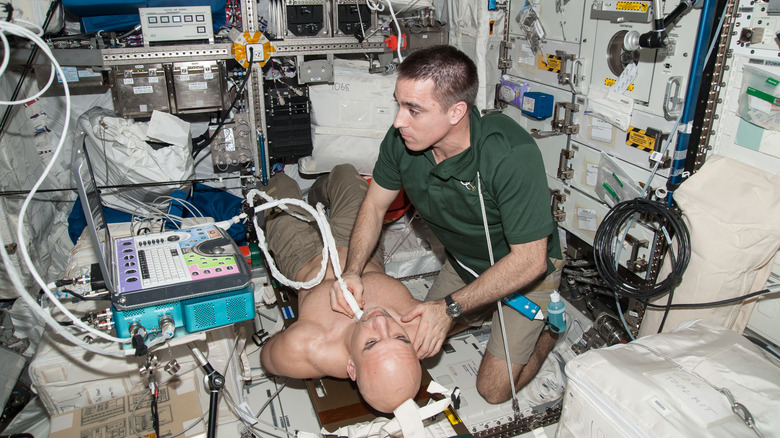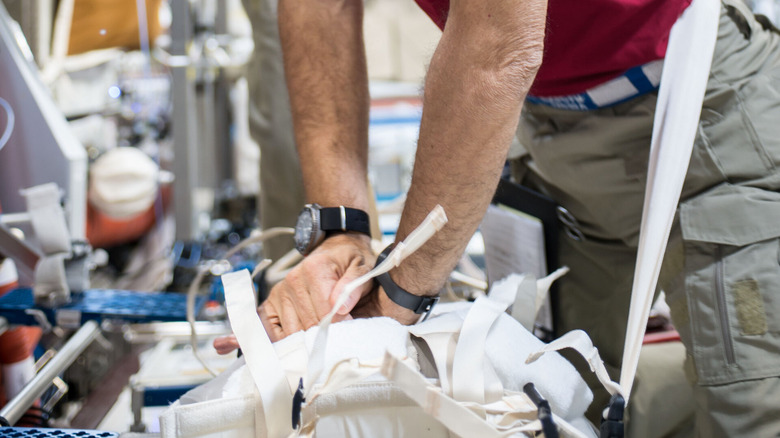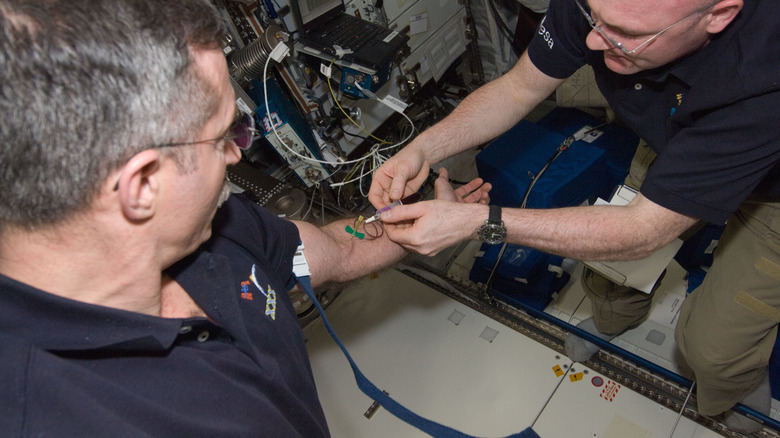The Complicated Process Of Performing Surgery In Space
When you think about the dangers of space, your mind most likely goes to explosions, fire, decompression, and other dramatic events. And while these kinds of emergencies absolutely pose a risk to astronauts and do need to be considered, there's another way in which space is dangerous — and that's in terms of medicine. There are all sorts of effects that the human body experiences from being in space, from fluids pooling in the upper part of the body to muscle loss to worsening eyesight. That's why astronauts who stay on the International Space Station spend so much time exercising and have regular medical tests.
There's another aspect of medical care in space that is even more challenging though, and that's dealing with emergencies. Fortunately, there's never been an astronaut emergency health issue that required surgery in space. But if there were a medical emergency on the ISS, it's near enough that an astronaut could be brought back to Earth for surgery if required. But what about longer missions? If we ever send astronauts to Mars, for example, they'll be millions of miles and months of travel away from the nearest hospital. In that case, we need to think about how to perform surgery in space — and that's anything but easy.
One of the biggest issues in trying to perform surgery in space would be the lack of gravity. Space stations and spacecraft have effectively no gravity, so they are technically called microgravity environments. And this means all sorts of complications in trying to perform surgery.
The problem of gravity
As fun as it would surely be to float around without gravity, it makes even simple tasks difficult. Think about trying to perform CPR, or cardiopulmonary resuscitation, where you push down on someone's chest to help their heart beat. On Earth, you would use your weight to press down on the chest, but that doesn't work in space. On the ISS, the patient has to be strapped into a special harness and the medical helper has a belt tied around them to keep them in place. European Space Agency astronaut Samatha Cristoforetti demonstrated this in a video posted to Twitter.
Then there are the effects of microgravity on the blood. In surgery, it's often necessary to cut someone open or to deal with bleeding. According to Nina Purvis, a researcher in space medicine at King's College London, that means complications. "Bodily fluids will also behave differently in space and on Mars," Purvis writes. "The blood in our veins may stick to instruments because of surface tension. Floating droplets may also form streams that could restrict the surgeon's view, which is not ideal."
If a surgeon's vision being impeded by blood droplets sounds unpleasant, be warned — it gets worse. Purvis writes that in experiments on performing open surgery on animals in microgravity, the intestines would float around and get in the way.
Dealing with the challenges
There are developing technologies and procedures to deal with these issues, like working more with keyhole surgeries rather than open surgeries (to be less invasive and have less chance of organs or fluids escaping the body), using magnetic surgical tools which will stick to the operating table and not float away, and having the surgeon held in place so they can exert force without floating away.
Researchers are working on methods to improve surgery in microgravity by performing tests on parabolic flights, which achieve weightlessness for a short time. A group of surgeons did manage to perform a simulated laparoscopy on a fake torso in these conditions. But there's a big difference between working on a fake torso and actually having to cut into your co-worker in an emergency. Purvis notes that the study authors warn that it would be psychologically difficult for astronauts to perform this kind of operation on one of their colleagues.
Future plans for longer missions such as a mission to Mars include using 3D printing to create surgical tools as required or using robots to perform surgeries, but we're a long way from having anything like that become operational.
For now, if there's a medical emergency in space we remain dependent on doctors giving telemedicine advice and bringing astronauts back to Earth for surgery if required. But we'll need to work on a way to deal with health emergencies if we want to visit other worlds in the future.


